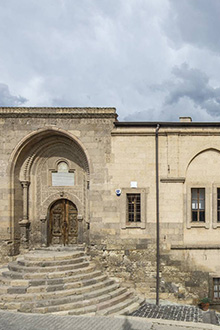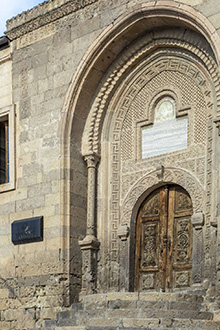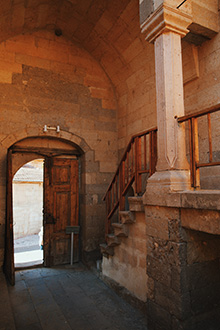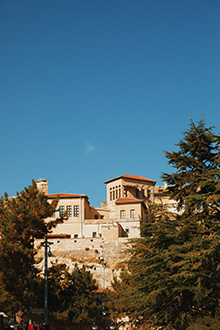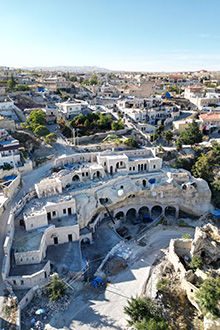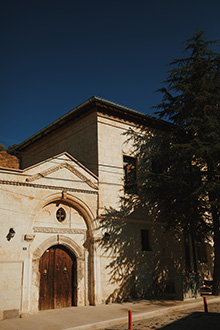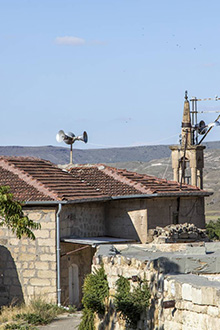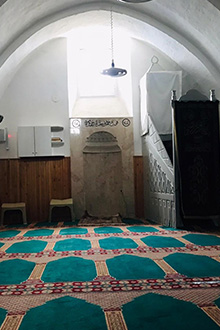

see
Prehistoric period finds unearthed in the Damsa Valley suggest that local people in the area made a living through trading. Over time, the center developed and, by the beginning of the 20th century, Mustafapaşa was one of Cappadocia’s most modern settlements, offering educational and cultural institutions, new art and lifestyles. The cultural components of Mustafapaşa included its diverse population: Orthodox Christians and Turks lived together in the village during the Ottoman era and, in fact, Christian residents of Mustafapaşa erected more than thirty places of worship in the village.
Mansions
Most of the mansions in Mustafapaşa were built by stone and masonry masters from Ürgüp. These homes are still intact today which indicates not only the skill of artisans, and their understanding of the region’s environmental conditions but also the characteristics of landlords in the design of structures. Approximately thirty of these homes offering visitors the feeling of a historical journey.
A Gracious Manner of Communicating: Door Knockers
When visiting the mansions, observe the door knockers the main entrances. Many of these features appear in Mustafapaşa mansions built in the second half of the 19th century.
The door knockers, in addition to providing notification of a visitor, served different functions. The specific appearance, pattern and symbols depicted on the door knocker also expressed the homeowner’s position in the community, such as their religious affiliation, economic and social status.
The wooden door of the Mehmet Şakir Pasha Madrasah, erected by an Ottoman pasha at the end of the 19th century, is particularly splendid, welcoming visitors with a dignified grandeur.
Mehmet Şakir Pasha Madrasah (Mehmet Şakir Paşa Medresesi)
The most important and magnificent Ottoman-era structure in Mustafapaşa, the Mehmet Şakir Pasha Madrasah, was erected in 1899 by Mehmet Şakir Pasha, an Egyptian, according to its inscription. Later, the madrasah functioned as a home and hosted workshop. Today, it serves its original educational function as the education building of Cappadocia University.
The crown gate of the madrasah, which had a rare splendor even at the time it was built, is a masterpiece among the stone carvings of the region. The double-winged wooden door features a plant relief, while its stone stepped arches, the pilasters and the entire wall surface are decorated with geometric reliefs.
Sheikh Ali Mosque (Şeyh Ali Camii)
Among the mosques in Mustafapaşa, the Sheikh Ali Mosque is the only mosque with an identified original epitaph and donor. The original minaret of the masjid, like the other two mosques in the village (Cami-i Kebir and Sipahi mosques), is in the form of a pavilion minaret and is in the southeast corner of the building.
Kebir Mosque (Cami-i Kebir)
Still used for worship, the centrally located Kebir Mosque has two minarets, one of which is the “pavilion minaret”, believed to be original. The other minaret was erected in 1976. The pavilion minaret is in the southeast corner of the mosque’s sanctuary/harim; it has a circular top cover with pointed arches surmounted by four pillars. Above this is a hexagonal cubic cone with a sideways crescent realm. Such minarets are also called “minbar minarets” because of their similarity to the minbar, and can be seen in numerous mosques and masjids built in the 19th century in the Cappadocia region, especially in Kayseri, Nevşehir and Kırşehir.
St. Basil Church (Aziz Basileios Kilisesi)
St. Basil Church is in the form of a structural complex consisting of different sections. Set on a hillside above the valley, the church includes spaces at different elevations carved into the rock below the present-day soil level. St. Basil Church has a special place among other Ottoman-era churches in Mustafapaşa and in the region, especially due to its frescoes.
Its namesake saint, “the Great Basil of Kayseri”, is the oldest and most well-known of the “Cappadocian Fathers”.
St. Nicholas Monastery Church and Other Churches in the Area
St. Nicholas Monastery, located in the Manastır Valley south of Mustafapaşa, is close to the center and can be reached by the road following Dere Street. As the most important religious building in the Manastır Valley, St. Nicholas Monastery is a complex structure dedicated to St. Nicholas, a figure of some importance to the people of Mustafapaşa.
There are multiple saints with the same name Nicholas, who are highly respected in the Orthodox faith, the saint for whom St. Nicholas Monastery is named was Nicholas, the former Bishop of Myra, who lived in the fourth century. His day of remembrance is December 6 and he was a renowned personage revered not only by the Christians of Sinasos but also by the entire Christian world as St. Nick, the “Santa Claus” of the western world.
In addition to its religious significance, St. Nicholas Monastery figured prominently in the social lives of the people in 19th-century Sinasos. It was alleged that the waters flowing from the fountain in the church’s courtyard had healing effect. Turks, as well as Christians, would drink the healing waters from the fountain.
The Constantine and Helena Church (Konstantin ve Eleni Kilisesi)
In the past, the church was used for Sunday services, holidays and school ceremonies, as well as ceremonies to welcome the bishop’s guests and prayer-reading ceremonies for the health of the sultan or the success of the army. Open to visitors today, the church also hosts various cultural and artistic activities.
Maraşoğlu Bridge (Maraşoğlu Köprüsü)
The Maraşoğlu Bridge is a stone bridge connecting the neighborhoods of Gavras and Yeni Mahalle, as they were called during the Ottoman era. Made of cut stone with three pointed arches, the bridge is 16 meters long and 2.5 meters wide; it has undergone repairs at various times. The bridge is still used today as the shortest route between the two neighborhoods.
The first line of the inscription on the bridge, written in Ottoman Turkish, is “Built by Maraşoğlu Vasil”. The following six lines, written in Greek, are: “Like a link that connects two separate parts/I connect two neighbourhoods of the town. /But like the symbol of a glorious victory/I immortalize the virtue of our fellow countrymen. /God rest the soul of Vasilios Maraşoğlu.”
Fountains
Traditional Turkish fountains generally consist of a basin in front of a ringed mirror stone within an arched niche. In addition to single-façade and single-spout style fountains, there are also open-style fountains with multiple façades and spouts. The design of the historical fountains in Ürgüp and Mustafapaşa indicates that functionality was prioritized in these structures and aesthetic concerns were an afterthought. Ornamentation applied within the framework of a specific and limited program. The important and active fountain structures that can be seen in Mustafapaşa today include the Seyyid Mustafa Paşa Fountain (Kebir Mosque Mustafa Paşa Fountain), Yukarı Mahalle Fountain and the Square (Meydan) Fountain, also known as “şadırvan çeşme".

